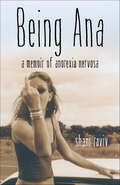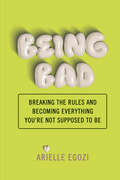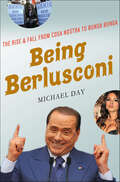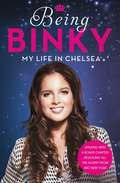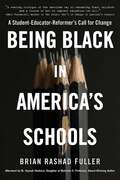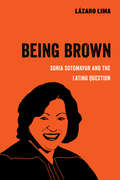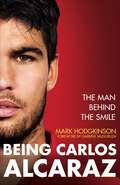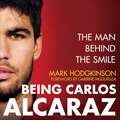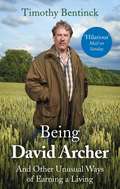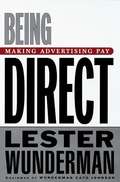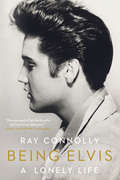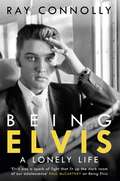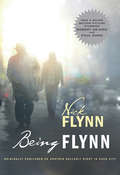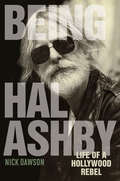- Table View
- List View
Being Ana: A Memoir of Anorexia Nervosa
by Shani RavivShani Raviv is a misfit teen whose peer-pressured diet spirals down into full-blown anorexia nervosa—something no one in her early-nineties, local South African community knows anything about. Fourteen-year-old Shani spends the next six years being “Ana” (as many anorexics call it), on the run from her feelings. She goes from aerobics addict to Israeli soldier to rave bunny to wannabe reborn, using sex, drugs, exercise and, above all, starvation, to numb out everything along the way. But one night, at age twenty, Shani faces the rude awakening that if she doesn’t slow down, break her denial, and seek help, she will starve to death. Three years later, her hardest journey of all begins: the journey to let go of being Ana and learn to love herself. Being Ana is an exploration into the soul and psyche of a young woman wrestling with anorexia’s demons—one that not only exposes the real horrors of a day in the life of an anorexic girl but also reveals the courage it takes to stop fighting and find healing.
Being Bad: This book is for anyone who has decided the rules don't apply.
by Arielle EgoziWhat happens when you stop giving a f*ck about what your parents, partners, and society expect of you and ask yourself what you really want?Salon’s inaugural sex and love advice columnist and author of the viral LinkedIn sex work post, Arielle Egozi, shares their journey as a queer, neurodivergent, child of immigrants who never quite fit into the social roles she was supposed to, instead choosing to embrace their multiple dimensions, and eventually discovering freedom—and true power—by being “bad” in a world that kept trying to force her to be “good.”What if sex positivity wasn’t about having sex at all? What if you ditched relationship hierarchies and explored relationship anarchy? How can everyone get in touch with their inner domme? Using frameworks and philosophies cultivated from years of living, writing, speaking, and educating on sex, relationships, and identity through a queer and decolonizing lens, Egozi offers questions, practices, and tools to help you find your own power, and step into it—creating space for you to dream far beyond what your family, society, or capitalist culture expects. Being Bad offers you the permission to become who you are, however you choose to be.
Being Berlusconi: The Rise & Fall from Cosa Nostra to Bunga Bunga
by Michael DayPeople from all walks of life are appalled and fascinated in equal measure by the stratospheric political career of the tycoon and three-time Italian Prime Minister Silvio Berlusconi.Michael Day provides an in depth look at the life and crimes of the shameless media mogul until his nine lives ran out and he faced definitive conviction which signaled his irreversible decline. He tells the story of a bright and ambitious man from a lower-middle class family who shook off his humble origins and rose to become rich and powerful beyond most people's dreams—a multi-billionaire whose Mediaset company remains one of Europe's largest television and cinema conglomerates. Along the way, amid the election victories, business triumphs, and womanizing, he became bogged down by his hubris, egotism, sexual obsessions, as well as his flagrant disregard for the law.And yet how and why did Italy and Italians put up with him for so long?With the 78-year-old's legal woes ongoing, including further trials for bribery, after a recent nine-month community service stint, Being Berlusconi: The Rise and Fall from Cosa Nostra to Bunga Bunga is well-timed to mark the final chapters of a notorious—and astonishing—life and career.
Being Binky
by Binky FelsteadWelcome to the glamorous life of Alexandra 'Binky' Felstead, original cast member and star of the hit TV programme, Made in Chelsea. In this tell-all account she reveals what it's really like BEING BINKY and what it takes to be a real Chelsea Girl. When the show launched in 2011, Binky was catapulted from a nine to five job as a receptionist at a hedge-fund into the limelight of reality TV fame. She's experienced many ups and downs on the show, from feuding with best friend Cheska and a failed romance with Jamie Laing to her new found friendship with Lucy Watson and being swept off her feet by Alex Mytton, the impact of Made in Chelsea on her life was immediate. Charting her overnight rise to fame and exploring her life outside of Made in Chelsea, for the first time, Binky opens up about her childhood, the bullying she was victim to at school and the difficulties of dealing with her parents' divorce. She talks candidly about body image, and dieting, and shares her beauty regime top tips. BEING BINKY lifts the lid on one of the series' favourite characters and provides a backstage pass to the secret and exclusive world of Chelsea.
Being Black in America's Schools: A Student-Educator-Reformer's Call for Change
by Brian Rashad FullerFor readers of The Knowledge Gap, Race to the Bottom, and The Inequality Machine, education and equity strategist Brian Rashad Fuller sheds a stark light on America's public schools, the miseducation of students of color, and the action required to make tangible changes and reforms to a failing and racialized educational system. With a foreword from Harriet Tubman's great-grand nephew, Abdul Tubman. In a polarizing and racially divided America, what do children of color learn about themselves before they even go to school? How do they see themselves and is that image only exacerbated by spending twelve years in a public education system that perpetuates negative stereotypes? Brian Rashad Fuller personally knows that the impact of low expectations can be devastating, as proved by the &“school to prison&” pipeline that so many students have experienced. He aims to make a difference in this humanizing and very personal portrayal of what it means to be Black in America&’s schools. As a Black man who has spent his life as a student and an educator, Brian shares his own story of navigating the world, overcoming his family struggles, and eventually entering an educational system that he believes is inherently racist, damaging, and disserving. He exposes the challenges Black students face in elite and predominantly white universities and spaces, dissects &“Black exceptionalism&” in the schooling experience, and offers a firsthand account of the emotional and psychological impact made by teachers, administrators, policies, practices, lessons, and student interactions. Most Americans are looking for answers on how to improve our education system—as illustrated by the critical race theory debate—but have not fully understood the lived Black experience, until now. With powerful insight into a thoroughly American institution, Brian offers present-day solutions, and liberating hope, for a centuries-long issue, as well as a galvanizing and radical step forward. It is a book essential to our challenging times.
Being Brown: Sonia Sotomayor and the Latino Question (American Studies Now: Critical Histories of the Present #9)
by Lázaro LimaBeing Brown: Sonia Sotomayor and the Latino Question tells the story of the country’s first Latina Supreme Court Associate Justice’s rise to the pinnacle of American public life at a moment of profound demographic and political transformation. While Sotomayor’s confirmation appeared to signal the greater acceptance and inclusion of Latinos—the nation’s largest “minority majority”—the uncritical embrace of her status as a “possibility model” and icon paradoxically erased the fact that her success was due to civil rights policies and safeguards that no longer existed. Being Brown analyzes Sotomayor’s story of success and accomplishment, despite seemingly insurmountable odds, in order to ask: What do we lose in democratic practice when we allow symbolic inclusion to supplant the work of meaningful political enfranchisement? In a historical moment of resurgent racism, unrelenting Latino bashing, and previously unimaginable “blood and soil” Nazism, Being Brown explains what we stand to lose when we allow democratic values to be trampled for the sake of political expediency, and demonstrates how understanding “the Latino question” can fortify democratic practice. Being Brown provides the historical vocabulary for understanding why the Latino body politic is central to the country’s future and why Sonia Sotomayor’s biography provides an important window into understanding America, and the country’s largest minority majority, at this historical juncture. In the process, Being Brown counters “alternative facts” with historical precision and ethical clarity to invigorate the best of democratic practice at a historical moment when we need it most.
Being Carlos Alcaraz: The Man Behind the Smile
by Mark Hodgkinson'A perfect match of author and subject. Mark Hodgkinson's mix of style and substance - flair and professionalism - mirrors Carlos Alcaraz on a tennis court.'- Jon Wertheim, a senior writer at Sports Illustrated'This is a great window into the background and processes of arguably the most exciting player in men's tennis right now.' - Charlie Eccleshare, tennis correspondent for the New York Times and The Athletic 'A highly readable portrait of tennis's most exciting young talent.'- Conor Niland, a former tennis player and the winner of the William Hill Sports Book of the Year award 2024 for 'The Racket''This is a brilliant book. The detail on offer is extraordinary ... A cracking read for any tennis fan.'- Courtney Walsh, Fox Sports in AustraliaA deeply researched biography of the new (smiley) face of tennis. A global star who has achieved more than Novak Djokovic, Rafael Nadal and Roger Federer did by this stage of their careers. At just 19 years old, Carlos Alcaraz won the US Open and became the youngest ever men's world number one. At only 21, he already had four Grand Slam titles.For Alcaraz, everything - from his charm to his star power to his tennis mojo - starts with a smile. But there is a more complex character behind the smile. One who grew up in modest circumstances in a small village in Murcia in southern Spain. A man with strong family traditions who has a tattoo of his grandfather's favourite saying - 'cabeza, corazon y cojones' (brain, heart and balls) - inked on his left wrist.Mark Hodgkinson talks to those who know Alcaraz best - including his coaches, old teachers and competitors - to provide a fascinating insight into a showman with ambitions of becoming the GOAT, the greatest of all time.
Being Carlos Alcaraz: The Man Behind the Smile
by Mark Hodgkinson'A perfect match of author and subject. Mark Hodgkinson's mix of style and substance - flair and professionalism - mirrors Carlos Alcaraz on a tennis court.'- Jon Wertheim, a senior writer at Sports Illustrated'This is a great window into the background and processes of arguably the most exciting player in men's tennis right now.' - Charlie Eccleshare, tennis correspondent for the New York Times and The Athletic 'A highly readable portrait of tennis's most exciting young talent.'- Conor Niland, a former tennis player and the winner of the William Hill Sports Book of the Year award 2024 for 'The Racket''This is a brilliant book. The detail on offer is extraordinary ... A cracking read for any tennis fan.'- Courtney Walsh, Fox Sports in AustraliaA deeply researched biography of the new (smiley) face of tennis. A global star who has achieved more than Novak Djokovic, Rafael Nadal and Roger Federer did by this stage of their careers. At just 19 years old, Carlos Alcaraz won the US Open and became the youngest ever men's world number one. At only 21, he already had four Grand Slam titles.For Alcaraz, everything - from his charm to his star power to his tennis mojo - starts with a smile. But there is a more complex character behind the smile. One who grew up in modest circumstances in a small village in Murcia in southern Spain. A man with strong family traditions who has a tattoo of his grandfather's favourite saying - 'cabeza, corazon y cojones' (brain, heart and balls) - inked on his left wrist.Mark Hodgkinson talks to those who know Alcaraz best - including his coaches, old teachers and competitors - to provide a fascinating insight into a showman with ambitions of becoming the GOAT, the greatest of all time.
Being Carlos Alcaraz: The Man Behind the Smile
by Mark Hodgkinson'A perfect match of author and subject. Mark Hodgkinson's mix of style and substance - flair and professionalism - mirrors Carlos Alcaraz on a tennis court.'- Jon Wertheim, a senior writer at Sports Illustrated'This is a great window into the background and processes of arguably the most exciting player in men's tennis right now.' - Charlie Eccleshare, tennis correspondent for the New York Times and The Athletic 'A highly readable portrait of tennis's most exciting young talent.'- Conor Niland, a former tennis player and the winner of the William Hill Sports Book of the Year award 2024 for 'The Racket''This is a brilliant book. The detail on offer is extraordinary ... A cracking read for any tennis fan.'- Courtney Walsh, Fox Sports in AustraliaA deeply researched biography of the new (smiley) face of tennis. A global star who has achieved more than Novak Djokovic, Rafael Nadal and Roger Federer did by this stage of their careers. At just 19 years old, Carlos Alcaraz won the US Open and became the youngest ever men's world number one. At only 21, he already had four Grand Slam titles.For Alcaraz, everything - from his charm to his star power to his tennis mojo - starts with a smile. But there is a more complex character behind the smile. One who grew up in modest circumstances in a small village in Murcia in southern Spain. A man with strong family traditions who has a tattoo of his grandfather's favourite saying - 'cabeza, corazon y cojones' (brain, heart and balls) - inked on his left wrist.Mark Hodgkinson talks to those who know Alcaraz best - including his coaches, old teachers and competitors - to provide a fascinating insight into a showman with ambitions of becoming the GOAT, the greatest of all time.
Being David Archer: And Other Unusual Ways of Earning a Living
by Timothy BentinckTimothy Bentinck has played the part of David Archer in BBC Radio 4's The Archers since 1982. He is also the Earl of Portland and the voice of 'Mind The Gap' on the Piccadilly Line. Aimed primarily at the five million regular Archers listeners, Timothy takes the reader behind the scenes of the longest running drama series in the world, a British institution with a theme tune that Billy Connolly wants to be the National Anthem. But that's not all. With wry, self-deprecating humour, Timothy recounts his enormously varied life - a successful actor in TV, film and theatre, a voice specialist working in every vocal medium. He's also been an HGV truck driver, a US tour guide, a computer programmer and website designer, an inventor with UK and US patents, farm worker, house renovator and he sat as a crossbencher in the House of Lords for three years.Unlike many acting memoirs, this isn't a succession of thespian tales of freezing digs, forgotten lines and name dropping. This is an articulate, funny and thoughtful account of how to survive an insecure life.
Being David Archer: And Other Unusual Ways of Earning a Living
by Timothy Bentinck'Hilarious' Mail on Sunday'Stylish, very funny memoir' Daily MailTimothy Bentinck has played the part of David Archer in BBC Radio 4's The Archers since 1982. He is also the Earl of Portland and the voice of 'Mind The Gap' on the Piccadilly Line. Aimed primarily at the five million regular Archers listeners, Timothy takes the reader behind the scenes of the longest running drama series in the world, a British institution with a theme tune that Billy Connolly wants to be the National Anthem. But that's not all. With wry, self-deprecating humour, Timothy recounts his enormously varied life - a successful actor in TV, film and theatre, a voice specialist working in every vocal medium. He's also been an HGV truck driver, a US tour guide, a computer programmer and website designer, an inventor with UK and US patents, farm worker, house renovator and he sat as a crossbencher in the House of Lords for three years.Unlike many acting memoirs, this isn't a succession of thespian tales of freezing digs, forgotten lines and name dropping. This is an articulate, funny and thoughtful account of how to survive an insecure life.
Being David Archer: And Other Unusual Ways of Earning a Living
by Timothy BentinckTimothy Bentinck has played the part of David Archer in BBC Radio 4's The Archers since 1982. He is also the Earl of Portland and the voice of 'Mind The Gap' on the Piccadilly Line. Aimed primarily at the five million regular Archers listeners, Timothy takes the reader behind the scenes of the longest running drama series in the world, a British institution with a theme tune that Billy Connolly wants to be the National Anthem. But that's not all. With wry, self-deprecating humour, Timothy recounts his enormously varied life - a successful actor in TV, film and theatre, a voice specialist working in every vocal medium. He's also been an HGV truck driver, a US tour guide, a computer programmer and website designer, an inventor with UK and US patents, farm worker, house renovator and he sat as a crossbencher in the House of Lords for three years.Unlike many acting memoirs, this isn't a succession of thespian tales of freezing digs, forgotten lines and name dropping. This is an articulate, funny and thoughtful account of how to survive an insecure life.
Being Dead Is Bad for Business: A Memoir
by Stanley A. WeissMost of us spend our lives talking ourselves out of things. But what could you accomplish if you never held yourself back?What if, despite your fears, you went for broke every time? You might live a life as extraordinary as the one Stanley Weiss has lived for nearly a century.A skinny Jewish kid from Philadelphia training to fight and likely die in the U.S. invasion of Japan in 1945, Stanley Weiss came home to the death of his loving but weak father, who left his mother penniless. Inspired by a Humphrey Bogart movie, Weiss moved to a foreign country to hunt for treasure—where Rule Number One was ''Don't Die.'' Along the way, his zest for living has taken him from the company of legendary artists and poets in Mexico, to writers and beatniks in 1960s San Francisco and Hollywood; from drunken nights with a notorious spy to friendships with three of the men who played James Bond; from glamorous parties in Gstaad and Phuket to power politics in London and Washington, DC. For those who believe the world is shaped by ordinary people who push themselves to do extraordinary things, Stanley Weiss's story will inspire and surprise while reminding us all that being dead is bad for business—and being boring is bad for life.
Being Direct: Making Advertising Pay
by Lester WundermanLester Wunderman created the business known as direct marketing. He conceived and refined its basic strategies, and he gave it a name. Today, he is Chairman of Wunderman, Cato, Johnson, the largest direct marketing organization in the world.
Being Elvis: A Lonely Life
by Ray ConnollyOn the fortieth anniversary of Elvis Presley’s death comes this rocking biography of an iconic artist who fundamentally transformed American culture. Elvis Presley is a giant figure in American popular culture, a man whose talent and fame were matched only by his later excesses and tragic end. A godlike entity in the history of rock and roll, this twentieth-century icon with a dazzling voice blended gospel and traditionally black rhythm and blues with country to create a completely new kind of music and new way of expressing male sexuality, which simply blew the doors off a staid and repressed 1950s America. In Being Elvis veteran rock journalist Ray Connolly takes a fresh look at the career of the world’s most loved singer, placing him, forty years after his death, not exhaustively in the garish neon lights of Las Vegas but back in his mid-twentieth-century, distinctly southern world. For new and seasoned fans alike, Connolly, who interviewed Elvis in 1969, re-creates a man who sprang from poverty in Tupelo, Mississippi, to unprecedented overnight fame, eclipsing Frank Sinatra and then inspiring the Beatles along the way. Juxtaposing the music, the songs, and the incendiary live concerts with a personal life that would later careen wildly out of control, Connolly demonstrates that Elvis’s amphetamine use began as early as his touring days of hysteria in the late 1950s, and that the financial needs that drove him in the beginning would return to plague him at the very end. With a narrative informed by interviews over many years with John Lennon, Bob Dylan, B. B. King, Sam Phillips, and Roy Orbison, among many others, Connolly creates one of the most nuanced and mature portraits of this cultural phenomenon to date. What distinguishes Being Elvis beyond the narrative itself is Connolly’s more subtle examinations of white poverty, class aspirations, and the prison that is extreme fame. As we reach the end of this poignant account, Elvis’s death at forty-two takes on the hue of a profoundly American tragedy. The creator of an American sound that resonates today, Elvis remains frozen in time, an enduring American icon who could “seamlessly soar into a falsetto of pleading and yearning” and capture an inner emotion, perhaps of eternal yearning, to which all of us can still relate. Intimate and unsparing, Being Elvis explores the extravagance and irrationality inherent in the Elvis mythology, ultimately offering a thoughtful celebration of an immortal life.
Being Elvis: A Lonely Life
by Ray ConnollyThe perfect companion to Baz Luhrmann's forthcoming biopic Elvis, a major motion picture starring Tom Hanks and Austin Butler.What was it like to be Elvis Presley? What did it feel like when impossible fame made him its prisoner? As the world's first rock star there was no one to tell him what to expect, no one with whom he could share the burden of being himself - of being Elvis.On the outside he was all charm, sex appeal, outrageously confident on stage and stunningly gifted in the recording studio. To his fans he seemed to have it all. He was Elvis. With his voice and style influencing succeeding generations of musicians, he should have been free to sing any song he liked, to star in any film he was offered, and to tour in any country he chose. But he wasn't free. The circumstances of his poor beginnings in the American South, which, as he blended gospel music with black rhythm and blues and white country songs, helped him create rock and roll, had left him with a lifelong vulnerability. Made rich and famous beyond his wildest imaginings when he mortgaged his talent to the machinations of his manager, 'Colonel' Tom Parker, there would be an inevitable price to pay. Though he daydreamed of becoming a serious film actor, instead he grew to despise his own movies and many of the songs he had to sing in them. He could have rebelled. But he didn't. Why? In the Seventies, as the hits rolled in again, and millions of fans saw him in a second career as he sang his way across America, he talked of wanting to tour the world. But he never did. What was stopping him?BEING ELVIS takes a clear-eyed look at the most-loved entertainer ever, and finds an unusual boy with a dazzling talent who grew up to change popular culture; a man who sold a billion records and had more hits than any other singer, but who became trapped by his own frailties in the loneliness of fame.
Being Elvis: The perfect companion to Baz Luhrmann’s major biopic
by Ray ConnollyThe perfect companion to Baz Luhrmann's forthcoming biopic Elvis, a major motion picture starring Tom Hanks and Austin Butler.What was it like to be Elvis Presley? What did it feel like when impossible fame made him its prisoner? As the world's first rock star there was no one to tell him what to expect, no one with whom he could share the burden of being himself - of being Elvis.On the outside he was all charm, sex appeal, outrageously confident on stage and stunningly gifted in the recording studio. To his fans he seemed to have it all. He was Elvis. With his voice and style influencing succeeding generations of musicians, he should have been free to sing any song he liked, to star in any film he was offered, and to tour in any country he chose. But he wasn't free. The circumstances of his poor beginnings in the American South, which, as he blended gospel music with black rhythm and blues and white country songs, helped him create rock and roll, had left him with a lifelong vulnerability. Made rich and famous beyond his wildest imaginings when he mortgaged his talent to the machinations of his manager, 'Colonel' Tom Parker, there would be an inevitable price to pay. Though he daydreamed of becoming a serious film actor, instead he grew to despise his own movies and many of the songs he had to sing in them. He could have rebelled. But he didn't. Why? In the Seventies, as the hits rolled in again, and millions of fans saw him in a second career as he sang his way across America, he talked of wanting to tour the world. But he never did. What was stopping him?BEING ELVIS takes a clear-eyed look at the most-loved entertainer ever, and finds an unusual boy with a dazzling talent who grew up to change popular culture; a man who sold a billion records and had more hits than any other singer, but who became trapped by his own frailties in the loneliness of fame.
Being Elvis: The perfect companion to Baz Luhrmann’s major biopic
by Ray ConnollyThe perfect companion to Baz Luhrmann's forthcoming biopic Elvis, a major motion picture starring Tom Hanks and Austin Butler.What was it like to be Elvis Presley? What did it feel like when impossible fame made him its prisoner? As the world's first rock star there was no one to tell him what to expect, no one with whom he could share the burden of being himself - of being Elvis.On the outside he was all charm, sex appeal, outrageously confident on stage and stunningly gifted in the recording studio. To his fans he seemed to have it all. He was Elvis. With his voice and style influencing succeeding generations of musicians, he should have been free to sing any song he liked, to star in any film he was offered, and to tour in any country he chose. But he wasn't free. The circumstances of his poor beginnings in the American South, which, as he blended gospel music with black rhythm and blues and white country songs, helped him create rock and roll, had left him with a lifelong vulnerability. Made rich and famous beyond his wildest imaginings when he mortgaged his talent to the machinations of his manager, 'Colonel' Tom Parker, there would be an inevitable price to pay. Though he daydreamed of becoming a serious film actor, instead he grew to despise his own movies and many of the songs he had to sing in them. He could have rebelled. But he didn't. Why? In the Seventies, as the hits rolled in again, and millions of fans saw him in a second career as he sang his way across America, he talked of wanting to tour the world. But he never did. What was stopping him?BEING ELVIS takes a clear-eyed look at the most-loved entertainer ever, and finds an unusual boy with a dazzling talent who grew up to change popular culture; a man who sold a billion records and had more hits than any other singer, but who became trapped by his own frailties in the loneliness of fame.
Being Flynn (Movie Tie-in Edition) (Movie Tie-in Editions)
by Nick FlynnThis "stunningly beautiful memoir" (San Francisco Chronicle) is now a major motion picture starring Robert De Niro and Paul Dano. A Focus Features production, Nick Flynn's moving memoir of his relationship with his father is directed by Paul Weitz, whose films include About a Boy and Little Fockers.
Being Freddie: My Story So Far
by Andrew FlintoffAndrew 'Freddie' Flintoff is one of the most exciting cricketers in the world and has improved out of all recognition during the last two years. In 2003, he was England's best player at the World Cup. Then, explosively, he lit up the second half of the summer in 2004, lifting spirits at Lord's with a bat-smashing 142. He walked off with the England man of the series award and averages to flaunt. This book marks his story so far in his own words, taking us up to and including the summer of 2005, during which Flintoff has performed heroics with both bat and ball against Australia. Freddie will highlight the moments and matches in his career that helped him dramatically on his way forward, and reveals what it is like to play for one of the most successful England cricket teams in history.
Being Freddie: The Makings of an Incredible Career
by Andrew FlintoffAndrew 'Freddie' Flintoff is one of the most exciting cricketers in the world and has improved out of all recognition during the last two years. In 2003, he was England's best player at the World Cup. Then, explosively, he lit up the second half of the summer in 2004, lifting spirits at Lord's with a bat-smashing 142. He walked off with the England man of the series award and averages to flaunt. This book marks his story so far in his own words, taking us up to and including the summer of 2005, during which Flintoff has performed heroics with both bat and ball against Australia. Freddie will highlight the moments and matches in his career that helped him dramatically on his way forward, and reveals what it is like to play for one of the most successful England cricket teams in history.
Being George Washington
by Glenn BeckIF YOU THINK YOU KNOW GEORGE WASHINGTON, THINK AGAIN.This is the amazing true story of a real-life superhero who wore no cape and possessed no special powers--yet changed the world forever. It's a story about a man whose life reads as if it were torn from the pages of an action novel: Bullet holes through his clothing. Horses shot out from under him. Unimaginable hardship. Disease. Heroism. Spies and double-agents. And, of course, the unmistakable hand of Divine Providence that guided it all.Being George Washington is a whole new way to look at history. You won't simply read about the awful winter spent at Valley Forge--you'll live it right alongside Washington. You'll be on the boat with him crossing the Delaware, in the trenches with him at Yorktown, and standing next to him at the Constitutional Convention as a new republic is finally born.Through these stories you'll not only learn our real history (and how it applies to today), you'll also see how the media and others have distorted our view of it. It's ironic that the best-known fact about George Washington--that he chopped down a cherry tree--is a complete lie. It's even more ironic when you consider that a lie was thought necessary to prove he could not tell one.For all of his heroism and triumphs, Washington's single greatest accomplishment was the man he created in the process: courageous and principled, fair and just, respectful to all. But he was also something else: flawed.It's those flaws that should give us hope for today. After all, if Washington had been perfect, then there would be no way to build another one. That's why this book is not just about being George Washington in 1776, it's about the struggle to be him every single day of our lives. Understanding the way he turned himself from an uneducated farmer into the Indispensable (yet imperfect) Man, is the only way to build a new generation of George Washingtons that can take on the extraordinary challenges that America is once again facing.
Being Hal Ashby: Life of a Hollywood Rebel (Screen Classics)
by Nick DawsonThe story of the director behind Harold and Maude, Being There, and other quirky classics: &“A superb biography of this troubled, talented man.&” —Tucson Citizen Hal Ashby set the standard for subsequent independent filmmakers by crafting unique, thoughtful, and challenging films that continue to influence new generations of directors. Initially finding success as an editor, Ashby won an Academy Award for editing 1967&’s In the Heat of the Night, and translated his skills into a career as one of the quintessential directors of 1970s. Perhaps best remembered for the enduring cult classic Harold and Maude, Ashby quickly became known for melding quirky comedy and intense drama with performances from A-list actors such as Jack Nicholson in The Last Detail, Warren Beatty and Goldie Hawn in Shampoo, Jon Voight and Jane Fonda in Coming Home, and Peter Sellers and Shirley MacLaine in Being There. But Ashby&’s personal life was difficult. After enduring his parents&’ divorce, his father&’s suicide, and his own failed marriage all before the age of nineteen, he became notorious for his drug abuse, which contributed to the decline of his career near the end of his life. Ashby always operated outside Hollywood&’s conventions, and though his output was tragically limited, the quality of his films continues to inspire modern directors as varied and talented as Judd Apatow and Wes Anderson, both of whom acknowledge Ashby as a primary influence. In Being Hal Ashby: Life of a Hollywood Rebel, the first full-length biography of the maverick filmmaker, Nick Dawson masterfully tells the turbulent story of Ashby&’s life and career.
Being Henry: The Fonz . . . and Beyond
by Henry WinklerInstant New York Times Bestseller! From Emmy-award winning actor, author, comedian, producer, and director Henry Winkler, a deeply thoughtful memoir of the lifelong effects of stardom and the struggle to become whole.Henry Winkler, launched into prominence as “The Fonz” in the beloved Happy Days, has transcended the role that made him who he is. Brilliant, funny, and widely-regarded as the nicest man in Hollywood (though he would be the first to tell you that it’s simply not the case, he’s really just grateful to be here), Henry shares in this achingly vulnerable memoir the disheartening truth of his childhood, the difficulties of a life with severe dyslexia, the pressures of a role that takes on a life of its own, and the path forward once your wildest dream seems behind you. Since the glorious era of Happy Days fame, Henry has endeared himself to a new generation with roles in such adored shows as Arrested Development, Parks and Recreation, and Barry, where he’s been revealed as an actor with immense depth and pathos, a departure from the period of his life when he was so distinctly typecast as The Fonz, he could hardly find work. Filled with profound heart, charm, and self-deprecating humor, Being Henry is a memoir about so much more than a life in Hollywood and the curse of stardom. It is a meaningful testament to the power of sharing truth and kindness and of finding fulfillment within yourself.
